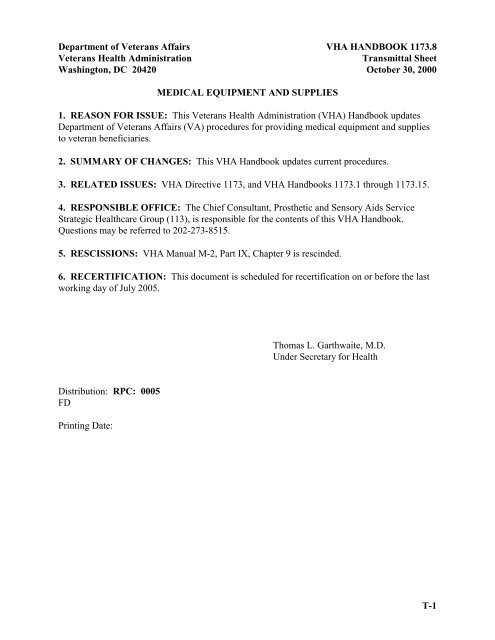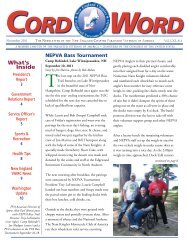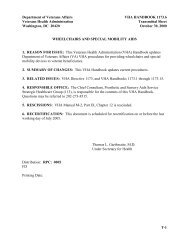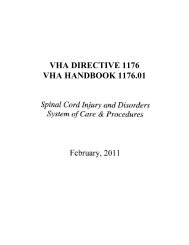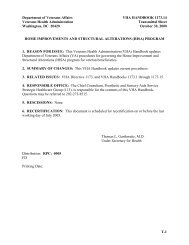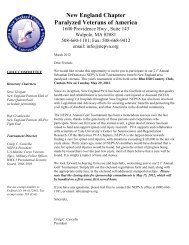VHA Handbook 1173.8, Medical Equipment and Supplies
VHA Handbook 1173.8, Medical Equipment and Supplies
VHA Handbook 1173.8, Medical Equipment and Supplies
- No tags were found...
You also want an ePaper? Increase the reach of your titles
YUMPU automatically turns print PDFs into web optimized ePapers that Google loves.
Department of Veterans Affairs <strong>VHA</strong> HANDBOOK <strong>1173.8</strong>Veterans Health AdministrationTransmittal SheetWashington, DC 20420 October 30, 2000MEDICAL EQUIPMENT AND SUPPLIES1. REASON FOR ISSUE: This Veterans Health Administration (<strong>VHA</strong>) <strong>H<strong>and</strong>book</strong> updatesDepartment of Veterans Affairs (VA) procedures for providing medical equipment <strong>and</strong> suppliesto veteran beneficiaries.2. SUMMARY OF CHANGES: This <strong>VHA</strong> <strong>H<strong>and</strong>book</strong> updates current procedures.3. RELATED ISSUES: <strong>VHA</strong> Directive 1173, <strong>and</strong> <strong>VHA</strong> <strong>H<strong>and</strong>book</strong>s 1173.1 through 1173.15.4. RESPONSIBLE OFFICE: The Chief Consultant, Prosthetic <strong>and</strong> Sensory Aids ServiceStrategic Healthcare Group (113), is responsible for the contents of this <strong>VHA</strong> <strong>H<strong>and</strong>book</strong>.Questions may be referred to 202-273-8515.5. RESCISSIONS: <strong>VHA</strong> Manual M-2, Part IX, Chapter 9 is rescinded.6. RECERTIFICATION: This document is scheduled for recertification on or before the lastworking day of July 2005.Thomas L. Garthwaite, M.D.Under Secretary for HealthDistribution: RPC: 0005FDPrinting Date:T-1
October 30, 2000 <strong>VHA</strong> HANDBOOK <strong>1173.8</strong>CONTENTSMEDICAL EQUIPMENT AND SUPPLIESPARAGRAPHPAGE1. Purpose ...................................................................................................................................... 12. Definitions ................................................................................................................................. 13. Scope ......................................................................................................................................... 14. Issuing <strong>Medical</strong> <strong>Equipment</strong> for Home Use ............................................................................... 25. Beneficiary Services Contract ................................................................................................... 76. Patient Education <strong>and</strong> JCAHO St<strong>and</strong>ards ................................................................................. 77. Respiratory <strong>Equipment</strong> ............................................................................................................. 78. <strong>Medical</strong> <strong>Supplies</strong> ....................................................................................................................... 89. Replacement <strong>and</strong> Spare <strong>Equipment</strong> .......................................................................................... 810. Repairs .................................................................................................................................... 811. Issuance of <strong>Medical</strong> <strong>Equipment</strong> .............................................................................................. 8i
October 30, 2000 <strong>VHA</strong> HANDBOOK <strong>1173.8</strong>1. PURPOSEMEDICAL EQUIPMENT AND SUPPLIESThis Veterans Health Administration (<strong>VHA</strong>) <strong>H<strong>and</strong>book</strong> establishes uniform <strong>and</strong> consistentnational procedures for providing medical equipment <strong>and</strong> supplies to veteran beneficiaries.2. DEFINITIONSa. Beneficiary Service Contract. A beneficiary service contract is a competitively bid,locally-awarded contract for the purchase, delivery, set-up, recovery <strong>and</strong> storage of major itemsof medical equipment used by veteran beneficiaries for the treatment of their specific disabilities.b. <strong>Medical</strong> <strong>Equipment</strong>. <strong>Medical</strong> equipment includes all items of a therapeutic orrehabilitative nature which are determined as medically necessary for home treatment of eligibleveterans, e.g., hospital beds, over-bed tables, bathroom equipment, invalid lifts, h<strong>and</strong>bikes, stairglides, room air conditioners, st<strong>and</strong>ing tables, portable ramps, mobility (walking) aids,environmental control units, etc.c. <strong>Medical</strong> <strong>Supplies</strong>. <strong>Medical</strong> supplies are expendable items required on a recurring basis forthe home treatment of specific disabilities, e.g., incontinence supplies, sheepskins, catheters, etc.d. Respiratory <strong>Equipment</strong>. Mechanical devices to support or aid patients in normalrespiration, e.g., concentrators, ventilators, C-PAPs, Bi-PAPs, nebulizers, humidifiers, masks,canulas, etc. NOTE: For further information regarding home respiratory equipment, refer to<strong>VHA</strong> <strong>H<strong>and</strong>book</strong> 1173.13.3. SCOPEa. <strong>Medical</strong> equipment, supplies <strong>and</strong> accessories are procured for, <strong>and</strong> issued or loaned to,eligible veterans upon receipt of a medical prescription in accordance with the procedures forproviding treatment contained in <strong>VHA</strong> <strong>H<strong>and</strong>book</strong> 1173.1, <strong>VHA</strong> <strong>H<strong>and</strong>book</strong> 1173.2, <strong>and</strong> thespecial instructions contained in this <strong>H<strong>and</strong>book</strong>. Strict adherence to the procedures concerningloaned equipment is required.b. <strong>Medical</strong> supplies will normally be provided by the Pharmacy Service; however, localcircumstances may necessitate the involvement of the Prosthetic Service in the purchase of someitems. Prosthetics representatives will remain flexible <strong>and</strong> provide those items necessary in theinterest of patient care. When circumstances require Prosthetic Service to be the primaryprovider of the medical supplies, documentation must be present for multi-level review.c. Prosthetic Services are responsible for providing home oxygen equipment, accessories <strong>and</strong>contract management. NOTE: For further information regarding home oxygen, see <strong>VHA</strong><strong>H<strong>and</strong>book</strong> 1173.13.1
<strong>VHA</strong> HANDBOOK <strong>1173.8</strong> October 30, 2000d. The use of a competitively bid, locally-awarded beneficiary service contract may beconsidered for the purchase, delivery, set up, recovery, reissue, maintenance <strong>and</strong> storage ofmedical equipment. This type contract should be considered if it will improve service <strong>and</strong> if theDepartment of Veterans Affairs (VA) facility does not have the available internal resources toprovide timely delivery <strong>and</strong> set-up in a veteran’s home. The use of this type of contract isoptional <strong>and</strong> supplemental methods may be indicated depending on local conditions.4. ISSUING MEDICAL EQUIPMENT FOR HOME USEa. Beds. Designated st<strong>and</strong>ard hospital beds (manual, semi-electric, electric) are to facilitatethe care of the patient by a caregiver.(1) Electric hospital beds, when not designated as st<strong>and</strong>ard issue, may be consideredwhenever they offer specific functions that would be advantageous to the patient's medicalcondition or if the attendant is unable to operate a manual bed. For example, spinal cord injuredpatients may gain a height advantage which facilitates transfers through the use of the high/lowfeature of an electric bed. Other bed-ridden patients may use an electric bed to change positions<strong>and</strong> thus provide better weight distribution.(2) Any request for other than a st<strong>and</strong>ard issue hospital bed must be prescribed <strong>and</strong>justification provided to support the need.(3) Accessories used with a hospital bed, e.g., mattresses, trapezes, over-bed tables, half- orfull-side rails, foot boards, etc., will be furnished as prescribed.b. Invalid Lifts. These lifts are electrically or manually operated <strong>and</strong> are designed to lift apatient from bed to wheelchair or wheelchair to bed. Invalid lifts may be considered whenprescribed for those patients who cannot transfer independently. NOTE: Training of the personwho is to operate the lift is essential prior to issuance of the lift.(1) Accessories, e.g., special purpose slings, may be furnished when prescribed.(2) Specialized lifts with an extended mast <strong>and</strong> smaller casters may be necessary for specialtybeds.c. Stair Glides(1) Electrically operated stair glides are designed to carry a patient from one level of the hometo another. In general, there are two types:(a) The platform type, which is designed to carry the patient while seated in a wheelchair.(b) The chair type, which requires a patient to transfer into a specially designed chair whichtravels up <strong>and</strong> down the staircase.2
October 30, 2000 <strong>VHA</strong> HANDBOOK <strong>1173.8</strong>(2) Stair glides may be furnished as part of medical <strong>and</strong>/or prosthetic services to eligibleveterans provided that they are medically necessary for the veteran's care <strong>and</strong> treatment. In manycases the need is apparent; e.g., access to dialysis equipment located in the basement of the home,access to an accessible bathroom, bedroom, etc. In other cases the need is not as clear; e.g.,exercise equipment located on another level, leather crafts or some other vocational pursuitprescribed for rehabilitation, etc.(3) The following action will be taken whenever a request for a stair glide is received:(a) A home visit by an evaluation team consisting of the Prosthetic representative <strong>and</strong>/or aPhysical Medicine <strong>and</strong> Rehabilitation Service (PM&RS) therapist or other appropriately trainedindividual to determine that alternative facilities or rooms suitable for the prescribed activity arenot available on the accessible level of the home.(b) An evaluation by PM&RS to assess the veteran's ability to safely transfer if a chair type ofstair glide is being requested.(4) If the veteran has maximized the amount of the Home Improvement <strong>and</strong> StructuralAlterations (HISA) benefit, the cost of installation must be borne by the veteran.d. Porch Lifts(1) Porch lifts which are electronically operated <strong>and</strong> designed to lift a wheelchair-boundpatient from the ground level to the entrance level of the patient's home may be furnished whenprescribed, provided they are the most effective <strong>and</strong> economical means of providing access to thehome. The possibility of using portable ramps or specially constructed ramps furnished underthe HISA program will always be considered.(2) If the veteran has maximized the HISA benefit, the cost of installation must be borne bythe veteran.e. Ramps(1) Portable ramps made of metal, fiberglass, etc., that are designed to allow access to a homeor van may be prescribed for a wheelchair-bound veteran when in compliance with the AmericanDisabilities Act Accessibility Guidelines. Portable ramps will be a first consideration prior to therequest of a permanent ramp under HISA benefits.(2) Permanent ramps constructed of wood, concrete or a combination thereof, are in thenature of a home improvement <strong>and</strong> may be furnished only as a HISA benefit, subject to theapplicable HISA benefit dollar limits. There is no other basis under Title 38 United States Code(U.S.C.) Chapter 17 for VA to provide permanent or custom-made ramps.3
<strong>VHA</strong> HANDBOOK <strong>1173.8</strong> October 30, 2000f. Air Conditioner(1) Room air conditioners, when prescribed, may be provided to an eligible veteran sufferingfrom spinal cord injuries, neurological conditions, <strong>and</strong> severe respiratory or coronary disease,which are substantially worsened by exposure to heat <strong>and</strong> humidity, <strong>and</strong> where the absence of acontrolled environment subjects the veteran to health-threatening circumstances.(2) If the veteran has maximized the amount of the HISA benefit, the cost of installation mustbe borne by the veteran.NOTE: Prosthetic <strong>and</strong> Sensory Aids Service (PSAS) provides an air conditioner only forprimary living quarters. If central air conditioning is required, it should only be consideredunder the HISA benefit.g. Environmental Control Unit (ECU). The ECU consists of an array of componentsdesigned to provide a seriously disabled patient the opportunity for independent action in some ofthe activities of daily living. The unit may be furnished when prescribed for high-level spinalcord injury patients, patients suffering from advanced neurological diseases or any othercondition when the patient has been rendered quadriplegic.(1) ECUs are normally voice-activated, switch-activated or a combination of voice <strong>and</strong> switchactivations. Voice-activated units are operated through verbal comm<strong>and</strong>s into a microphone.Switch-activated units are operated through a control panel, e.g., sip <strong>and</strong> puff device.(2) The selection of the appropriate activation tool for the veteran is critical to its successfulimplementation. The veteran should have, as a minimum, the following skills in order for theECU to be used effectively:(a) An underst<strong>and</strong>ing of cause <strong>and</strong> effect,(b) An underst<strong>and</strong>ing of timing issues involved with scanning (if used),(c) Perceptual acuity,(d) Controllable actions,(e) Repeatable actions,(f) Positional reliability,(g) Endurance,(h) Accuracy, <strong>and</strong>(i) An acceptance of assistive technology as a component of life.4
October 30, 2000 <strong>VHA</strong> HANDBOOK <strong>1173.8</strong>(3) As the goals are being determined by the PM&RS team <strong>and</strong> the veteran, the followingcritical areas should be considered:(a) Is the system going to be used in a single room or in several different environments?(b) Can the veteran use his/her switch for more than one task?(c) What intervention is necessary for the veteran to use the device?(d) With what level of complexity will the veteran feel comfortable?(4) Before the team designs the unit to be used, the medical issues related to the veteran’sneeds must be explored. The range of medical issues addressed by an ECU can vary from areduction of attendant care during the day, or telephone access for emergency assistance, to thesecurity of monitoring the home <strong>and</strong> controlling the entrance <strong>and</strong> lighting of the house. Severalof these factors are generally present <strong>and</strong> when properly addressed, the solution will contribute toan improvement in the veteran’s quality of life.(5) When the goals of the veteran have been determined <strong>and</strong> the most effective tool has beenidentified, the process of selecting a device to achieve these goals can begin. Underst<strong>and</strong>ing howthe device influences the environment is important to creating a successful solution. Some of thecommon effectors used with ECUs are infra-red (a non-visible beam of light that requires anunobscured path for transmission), radio frequency transmission (which can penetrate someobstacles), power line transmission (X-10) or ultra-sonic (not as common as it once was). Thesetransmission signals are used to cause an action in the object that is under control. The actionfrom the ECU should not interfere with the normal operation of the device in question.(6) Items within the home that can be controlled by an ECU are: lights (on <strong>and</strong> off, brighten,dim), appliances (on <strong>and</strong> off, brighten, dim), phone (answer, r<strong>and</strong>om dial, speed dial, hang-up,call waiting, etc.), infra-red remote control devices (TV, VCR, cable, stereo, DVD, CD player,satellite, etc.), bed control (foot, head, up <strong>and</strong> down mattress), accessories (door openers, pageturners, nurse calls), etc., <strong>and</strong> possibly medical equipment.(7) Prescriptions for environmental control units for home use shall be developed well inadvance of the patient's discharge. A home visit by a person knowledgeable about theequipment; e.g., Prosthetic representative, biomedical engineer, PM&RS therapist, etc., will bemade to ensure that conditions <strong>and</strong> attendants are compatible with the patient’s needs <strong>and</strong> that theequipment can be accommodated.(8) ECUs for use by long-term, severely disabled inpatients will be provided as with any otherhospital equipment. PSAS will not normally be involved with furnishing these units unlessdischarge is planned for the near future <strong>and</strong> an ECU is necessary to train the patient. In theseinstances, the ECU provided would be the unit installed in the patient’s home. NOTE: A listingof Prosthetic activities servicing SCI Centers is provided in M-2, Part XXIV.5
<strong>VHA</strong> HANDBOOK <strong>1173.8</strong> October 30, 2000h. Electric Lift Chairs. Electric lift chairs should be considered for patients who are unableto achieve the st<strong>and</strong>ing position when seated in a conventional height seat; however, they havethe ability to ambulate independently in a safe manner when in the st<strong>and</strong>ing position.i. Mobility <strong>and</strong>/or Walking Aids. Mobility <strong>and</strong>/or walking aids are devices used to supportthe body while walking: e.g., canes, crutches, walkers, etc.(1) St<strong>and</strong>ard wood canes, crutches <strong>and</strong> st<strong>and</strong>ard aluminum walkers (folding or non-folding)will be furnished to eligible veterans based upon the determination of medical need. PM&RSmay maintain the stock of these devices if PM&RS provides training in accordance with theestablished facility policy <strong>and</strong> guidelines.(2) Metal forearm crutches, or other specialized types of crutches, canes, <strong>and</strong>/or walkers willbe furnished to eligible veterans when specific determination of need is made by the prescribingphysician. Special types of crutches, canes, <strong>and</strong>/or walkers will not normally be furnished fortemporary disabilities, such as fractures, but will be limited to those cases when there is acontinued need over an extended period of time.(3) Accessories for crutches, canes, <strong>and</strong>/or walkers; i.e., h<strong>and</strong>grips, pads, tips, walker wheels,<strong>and</strong> brakes will be stocked <strong>and</strong> may be maintained by PM&RS to facilitate patient care. Issuancewill be in accordance with policy <strong>and</strong> procedures concerning eligibility <strong>and</strong> VA issue. Amechanism must be established between the PM&RS <strong>and</strong> the PSAS to maintain accurate recordson issuance of prosthetic appliances by PM&RS. These issuances must still be issued from stock<strong>and</strong> be accounted for in the National Prosthetics Patient Database.j. Recreational <strong>Equipment</strong>. VA is prohibited from providing recreational equipment whichdoes not fall under the broad definition of a prosthetic appliance (all aids, appliances, parts, <strong>and</strong>accessories which are required to replace, support, or substitute for a deformed, weakened, ormissing part of the body). Adaptive sporting equipment <strong>and</strong>/or prostheses that facilitate accessfor therapeutic <strong>and</strong> rehabilitative reasons may be provided to eligible veterans when prescribed.Examples of this type of equipment include, but are not limited to: artificial limbs designed foruse during swimming, artificial arms <strong>and</strong>/or h<strong>and</strong>s that facilitate access to the sport of archery orbow hunting, fishing, etc.(1) H<strong>and</strong>cycles, considered under the same guidelines as a sports-type wheelchair, are foundin <strong>H<strong>and</strong>book</strong> <strong>VHA</strong> 1173.6, “Wheelchairs <strong>and</strong> Special Mobility Aids.”(2) Exercise equipment may be issued if it is medically indicated for home, for example, aprescribed cardiac rehabilitation program, whereby the desired results cannot be achieved fromwalking, jogging or any other type of recommended home exercise program.k. Other Items of <strong>Medical</strong> <strong>Equipment</strong>. Other items of medical equipment, e.g., commode,shower chairs, alternating pressure pads, wheelchair cushions, flotation cushions, st<strong>and</strong>ing tables,grab-bars, raised toilet seats, traction units, etc., may be furnished to a veteran eligible under VAregulations when prescribed as being a necessary aspect of the veteran’s VA care <strong>and</strong> treatment.6
October 30, 2000 <strong>VHA</strong> HANDBOOK <strong>1173.8</strong>5. BENEFICIARY SERVICES CONTRACTa. A local beneficiary services contract is indicated when:(1) Delivery <strong>and</strong> pick-up services are not available within the facility resources.(2) The hospital discharge may be delayed <strong>and</strong>/or the care <strong>and</strong> treatment of outpatients may becompromised because of the time incurred by normal procurement procedures.b. Contract provisions may authorize the return of Government property in the possession ofthe contractor. In these instances, the contractor must provide a monthly inventory of VA-ownedproperty. Prosthetic representatives will reconcile the inventory in the same manner as otherprosthetic stock items. Unannounced periodic inspections will be conducted as indicated toresolve any differences.c. A single contract may be established for services to a single medical center or to severalmedical centers within the Veterans Integrated Service Network (VISN).d. Local contracts are negotiated by the Contracting Section of Acquisition <strong>and</strong> MaterielManagement Service or VISN-established acquisition centers based on the needs, specifications<strong>and</strong> work statements identified by PSAS.e. The inclusion of Prosthetic responsibilities in Joint Commission on Accreditation of HealthCare Organizations (JCAHO) st<strong>and</strong>ards (e.g., <strong>Equipment</strong> Management) has made the use of alocal contractor more important <strong>and</strong> more widely utilized for (at a minimum) delivery, equipmentset-up, patient education <strong>and</strong> proper pick-up, cleaning <strong>and</strong> storage of recovered equipment.f. Prosthetic activities will pay for the initial delivery, set-up, installation of medicalequipment (e.g., hospital beds, ramps, lifts, etc.) in the veteran’s home. If the veteran relocates,the cost of the transfer of the equipment from one residence to another shall be borne by theveteran.6. PATIENT EDUCATION AND JCAHO STANDARDSWhenever an eligible veteran is issued medical equipment, patient education must be provided<strong>and</strong> documented. JCAHO st<strong>and</strong>ards provide guidance for this documentation.7. RESPIRATORY EQUIPMENTFor further information regarding respiratory equipment, see <strong>VHA</strong> <strong>H<strong>and</strong>book</strong> 1173.13.7
<strong>VHA</strong> HANDBOOK <strong>1173.8</strong> October 30, 20008. MEDICAL SUPPLIESExpendable medical supplies generally required on a recurring basis for home treatment ofspecific disabilities including, but not limited to, incontinence supplies, colostomy, ileostomy,<strong>and</strong> urostomy supplies, urinals, catheters; etc., will normally be provided by the PharmacyService.a. PSAS may furnish certain items, which are not provided by the Pharmacy Service; e.g.,specific br<strong>and</strong>s, odd sized items, etc., when prescribed.8b. PSAS will not stock or furnish items normally provided by the Pharmacy Service.c. A limited stock of those medical supplies unavailable through the Pharmacy Service, maybe maintained by the Prosthetic Service for immediate issue to eligible veterans. The quantities<strong>and</strong> the amounts to be stocked will depend on local circumstances.9. REPLACEMENT AND SPARE EQUIPMENTa. <strong>Medical</strong> equipment will not be replaced until a determination is made, through a ProstheticService evaluation, that the current equipment is unsatisfactory for further use. Evaluationcriteria to consider include fair wear <strong>and</strong> tear <strong>and</strong> the repair cost involved.b. Generally, spare medical equipment, with the exception of respiratory equipment, will notbe provided unless there are unusual circumstances which would adversely affect the veteran'smedical condition. Multiple issues of expendable medical supplies are not considered in thecategory of issuing spare supplies.10. REPAIRSa. The procedures for repairs contained in <strong>VHA</strong> <strong>H<strong>and</strong>book</strong> 1173.1 <strong>and</strong> <strong>VHA</strong> <strong>H<strong>and</strong>book</strong>1173.2 apply to required repairs for medical equipment.b. Repairs to medical equipment may be obtained through internal VA facility resourcesprovided they are the most cost-effective, timely or convenient service for the veteran.11. ISSUANCE OF MEDICAL EQUIPMENTa. Prosthetic Service will coordinate the issuance of medical equipment with the locallyestablished Major <strong>Medical</strong> <strong>Equipment</strong> Committee, HISA Committee, Home Based Primary CareProgram, or the other applicable committee or team, <strong>and</strong> the professional service providing thecare <strong>and</strong> treatment to the veteran.b. The guidelines for the issuance of those specific items of medical equipment identified inthis chapter have been based upon the medical requirements of the eligible veteran. Althoughevery attempt has been made to develop realistic criteria, it is impossible to cover all items ofmedical equipment or all disabilities that require equipment. Physicians <strong>and</strong> Prosthetic personnel
October 30, 2000 <strong>VHA</strong> HANDBOOK <strong>1173.8</strong>must carefully evaluate each case based on the needs of the veteran, especially in cases of severedisability.c. Unusual requests or inquiries relating to the issuance of medical equipment may be referredto the Prosthetic Program officials in <strong>VHA</strong> Headquarters by submitting a VA Form 10-2641,Authorization for Issuance of Special <strong>and</strong>/or Experimental Appliances, in the normal manner.9


